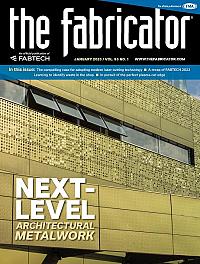CEO/Co-founder
- FMA
- The Fabricator
- FABTECH
- Canadian Metalworking
Categories
- Additive Manufacturing
- Aluminum Welding
- Arc Welding
- Assembly and Joining
- Automation and Robotics
- Bending and Forming
- Consumables
- Cutting and Weld Prep
- Electric Vehicles
- En Español
- Finishing
- Hydroforming
- Laser Cutting
- Laser Welding
- Machining
- Manufacturing Software
- Materials Handling
- Metals/Materials
- Oxyfuel Cutting
- Plasma Cutting
- Power Tools
- Punching and Other Holemaking
- Roll Forming
- Safety
- Sawing
- Shearing
- Shop Management
- Testing and Measuring
- Tube and Pipe Fabrication
- Tube and Pipe Production
- Waterjet Cutting
Industry Directory
Webcasts
Podcasts
FAB 40
Advertise
Subscribe
Account Login
Search
Metal fabrication’s era of change
Slide rules to Industry 4.0: All tools of the trade in metal manufacturing
- By Caleb Chamberlain
- January 10, 2023
- Article
- Shop Management
I have a set of old ivory drafting tools sitting on my desk. My late grandpa gave them to me when he retired. A slide rule, a protractor, and an old scale with an attached sticky note: Bought this in 1957 (January) for $0.68. Very good scale.
Memories, sentiment, and wonder are wrapped up together in these otherwise mundane-looking items. It means something to me that, after my grandpa emptied out his desk for the last time, he gifted his decades-old tools to his grandkids. These artifacts tell a story about change. My grandpa walked into a store somewhere and bought that old scale only three years after the first transistor radio was released. And who knows how to use a slide rule anymore? It’s a sort of arcane curiosity from a different era.
Back then, engineers like my grandpa designed everything by hand. It’s hard to imagine that process—no computers, no internet, just a library of datasheets, reference manuals, knowledgeable colleagues (one hopes), and a drafting table with paper. Yet it hasn’t been that long. We are only a generation or two removed from those days.
We all have the privilege of living through unparalleled change. Computers, the internet, and mobile phones have become so ubiquitous and convenient that it’s hard to imagine a world without them. I’m relatively young, but I still recall being floored when a friend pulled out an old Blackberry phone with a map and a GPS location on it. I didn’t have a cell phone until college. Even so, today I can barely imagine a world without the convenience of instant connectivity. We’ve become accustomed to change so quickly that it’s easy to forget just how different the world has become.
The pace of change is still slow enough that it escapes notice while we are in the weeds of our daily lives. But if we take a step back and watch what is happening, it’s absolutely jaw-dropping. By all rights, we should exclaim in amazement every time we pull out a smartphone to check the time. Or to watch a cat video, I guess.
People are changing too. Young adults today have never experienced a world without the internet. Imagine that. We may already take for granted that we can order almost anything online and have it in our hands tomorrow, but soon, nobody will even remember that it wasn’t always that way. That change in mindset represents a seismic shift. We’re a long way from when engineers never left home without a slide rule and spent their workdays hunched over drafting tables.
Just Getting Started
I came late to the party, but old industry hands have seen manufacturing methods change dramatically. CNC equipment, hyper-accurate hydraulic and electric presses, CO2 and fiber lasers, robotics, automation, internet, and email were all introduced within the lifetimes of people still running shops today. That’s incredible!
It’s hard to predict where this is all going, but we’re just getting started. Analysts and manufacturers have been talking about Industry 4.0 for years. Data-rich, cloud-connected, AI-driven, software-automated systems are poised to transform how fabricators operate. At least that’s what people say.
Ironically, while it seems like Industry 4.0 has incredible potential, we have difficulty describing it. We all expect change, but what does an Industry 4.0-enabled shop really look like? Examples in the literature focus on low-hanging fruit like predictive maintenance and supply chain analytics, but how many fab shops really care enough about predictive maintenance to hire a PhD-level engineer to gather data and build predictive models over the course of years?
It's hard to describe change while in the thick of it. It’s also difficult because Industry 4.0 solutions can be so application-specific. What applies to one manufacturing operation might be completely irrelevant in another. Finally, fabricators who ask, “How can I apply Industry 4.0 in my shop?” may be asking the wrong question. They’re taking a solution and looking for a problem.
Manufacturing is complicated, and fabricators are already best-in-class problem solvers. Industry 4.0 doesn’t change that; it just adds new tools to the toolbox. The Fourth Industrial Revolution is already happening organically, just slow enough that sometimes it’s only obvious in retrospect.
It’s also possible that widespread tech adoption is limited only by understanding. The purpose of this column is to help change that. This is the first in a series of articles that will explore how modern tech is affecting modern fabricators. I’ll provide concrete examples showing how software automation, data analytics, and machine learning have affected real operations. I hope to not only show what’s possible but also provide actionable insights.
An Industry 4.0 Case Study
Manufacturing is a treasure trove of unsolved problems. During my career as an electrical engineer, I built drones, autopilots, radio positioning systems, and wireless medical devices. I designed machine vision systems and AI algorithms to measure complicated systems and control robots. Yet after a decade immersed in cutting-edge tech, I’ve found that manufacturing is in many ways more complex and more interesting than any other so-called “high-tech” field.
Six years ago, my brother and I were building motion simulators; these were actuated chairs that let you wear a virtual reality headset and experience the motion you saw in the simulation. Imagine sitting in a virtual cockpit and flying an airplane or a rocket. It was just a passion project, but that’s what pulled us into the world of metal fabrication. Everything we built was cut from sheet metal or tube and welded together.
Our parts were one-offs and prototypes that would obviously never convert to volume production. For that reason, our jobs were understandably less interesting to local fabricators. That experience motivated us to open a new, on-demand fab service designed to take work other shops didn’t want to tackle. What followed was a predictable baptism by fire, while we struggled to learn how to run a high-mix fab shop.
We were pretty green. We were solving problems that experienced fabricators solved decades ago. Some of that involved figuring out things as mundane and obvious as storing inventory, but other problems were a little less trivial. There is so much to do: bidding, prepping part files, scheduling jobs, managing inventory, keeping track of production, accounting for scrap and rework, communicating with operators, shipping, billing. Fabrication is a busy job.
Four years in, we’ve worked out some kinks. There’s nothing remarkable about that, but because we entered the industry with a background in tech, our solutions have been tech-focused. We tend to write software that makes our lives easier. That has produced a shop that is a decent Industry 4.0 case study, at least for a high-mix job shop like ours.
Our entire front office is automated, from quoting to job prep, scheduling, nesting, NC generation, even inventory purchasing. The first time we see a job, it has already been checked for manufacturability, cleaned up and prepped, scheduled, nested with other orders, and staged for final review before being released to production.
Our production process itself is also driven by software. Consoles in our shop show 3D renderings of parts in every stage of production, along with relevant notes, attachments, and other details. Operators can perform value-adding work and move parts to the next production step, or scrap parts if needed. Scrapped parts are automatically nested for reproduction, to be reviewed and released by operators. Finally, finished jobs are scanned into boxes for shipping, and a system-generated bill of lading and shipping label is printed to finalize the job. Throughout the process, customers receive automated emails about the status of their orders.
We have no illusions about how well our systems might work for other shops. Fabrication technology is used in many ways across diverse industries. Our software was built by us, for us. We also know that we aren’t the only shop taking advantage of modern tech to build better processes.
Even so, we are passionate about metal fab and are excited about where it is headed. We hope to make a dent in the pace of tech adoption by sharing what we’ve done and what we’ve learned. To that end, future articles will include case studies, practical applications for AI and machine learning, and examples of the benefits of data-rich manufacturing, among other things. Much will be informed by practical applications on our own shop floor.
The pace of change is accelerating. Future generations may see today’s state-of-the-art tech in the same way we see old slide rules and drafting tables. It’s impossible to know how that world will look, but fabricators will quite literally help build that future, one metal part at a time. Fabricators need only continue doing what they do best: solve problems. As tech gives us new tools to work with, fabricators will change along with it. Hopefully for the better.
About the Author

Caleb Chamberlain
165 N. 1330 W #C4
Orem, UT 84057
801-850-7584
subscribe now

The Fabricator is North America's leading magazine for the metal forming and fabricating industry. The magazine delivers the news, technical articles, and case histories that enable fabricators to do their jobs more efficiently. The Fabricator has served the industry since 1970.
start your free subscription- Stay connected from anywhere

Easily access valuable industry resources now with full access to the digital edition of The Fabricator.

Easily access valuable industry resources now with full access to the digital edition of The Welder.

Easily access valuable industry resources now with full access to the digital edition of The Tube and Pipe Journal.
- Podcasting
- Podcast:
- The Fabricator Podcast
- Published:
- 04/16/2024
- Running Time:
- 63:29
In this episode of The Fabricator Podcast, Caleb Chamberlain, co-founder and CEO of OSH Cut, discusses his company’s...
- Trending Articles
Tips for creating sheet metal tubes with perforations

Supporting the metal fabricating industry through FMA

JM Steel triples capacity for solar energy projects at Pennsylvania facility

Are two heads better than one in fiber laser cutting?

Fabricating favorite childhood memories

- Industry Events
16th Annual Safety Conference
- April 30 - May 1, 2024
- Elgin,
Pipe and Tube Conference
- May 21 - 22, 2024
- Omaha, NE
World-Class Roll Forming Workshop
- June 5 - 6, 2024
- Louisville, KY
Advanced Laser Application Workshop
- June 25 - 27, 2024
- Novi, MI



























